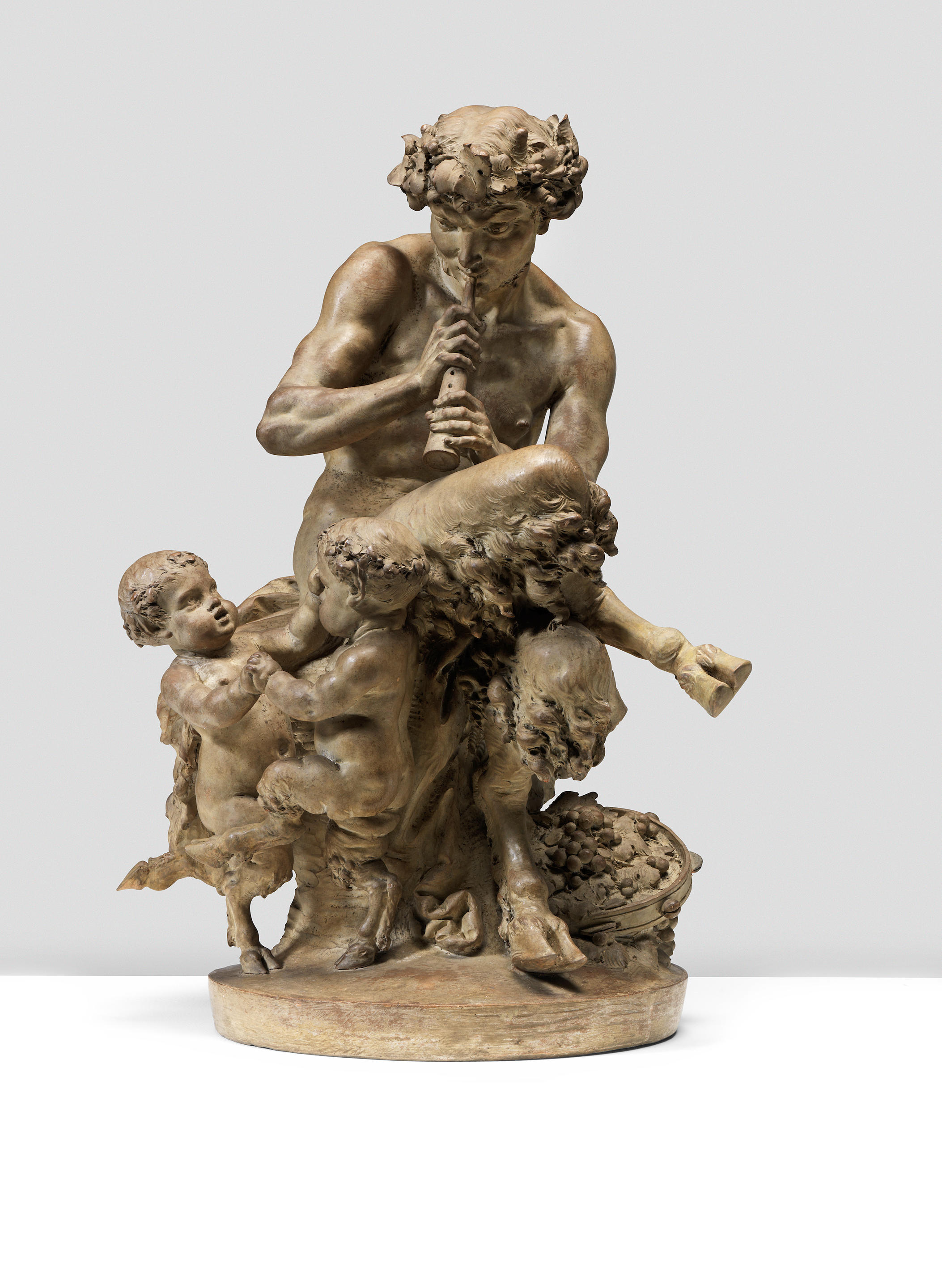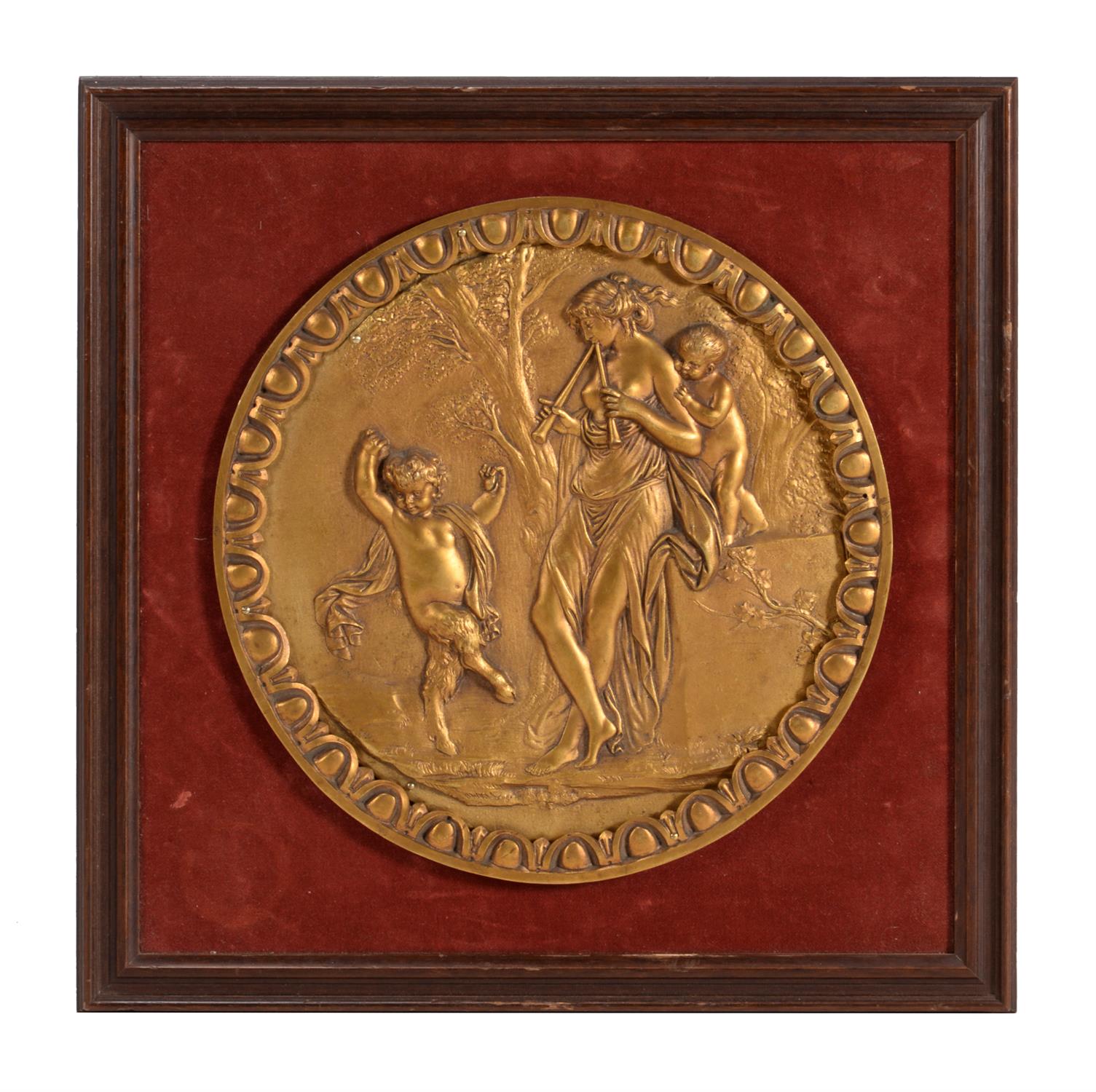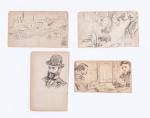Attributed to Claude Michel, called Clodion (French, 1738-1814) or perhaps Joseph Charles Marin (French, 1759-1834): a terracotta bust of a baccante, circa 1800Circa 1800 The young female with downcast eyes, her curling hair adorned with a fruiting vine wreath, her head turned slightly to dexter, her right arm adorned with an amulet and her loose drapery exposing her right breast, supported on a swept and beaded gilt bronze circular socle and raised on a 'bleu turquin' marble dwarf plain column pedestal with shallow stepped circular and square gilt bronze base, 32cm high overallFootnotesProvenance The collection of Sir Michael and Lady Oppenheimer DD (3rd Baronet, British, 1924-2020), Jersey, thence by family descent. Sir Michael Oppenheimer's maternal grandparents were Sir Robert Grenville Harvey, 2nd Baronet (1856-1931) and Lady Emily Blanche Harvey (1872-1935) of Langley Park, Buckinghamshire which was the Harvey Baronet's main family seat from 1788 until 1945. Sir Michael's paternal family wealth was derived from mining interests in South Africa and his father Bernard Oppenheimer, as Chairman of the South African Diamond Corporation, received a baronetcy from George V in 1921 for setting up diamond sorting factories to employ wounded ex-servicemen after the First World War. The Oppenheimer family was involved with the prestigious De Beers brand over the subsequent decades of the 20th century and Lady Oppenheimer DD (1926-2022) was a distinguished moral and philosophical theologian, with a particular interest in the ethics pertaining to personal relationships. Claude Michel, called Clodion, was perhaps one of the most celebrated European sculptors of the 18th century. Born in Nancy in northeast France, he was a contemporary of Houdon and Fragonard and in his teenage years he travelled to Paris to enrol in the studio of his uncle Lambert-Sigisbert Adam's sculptural studio working on competitions pieces for the Academy. He subsequently enrolled as a pupil at the studio of Jean Baptiste Pigalle (French, 1714-1785) which fortuitously enabled him to win the prestigious Prix de Rome. Leaving Paris in 1762 to travel to Rome, Clodion spent nine years refining his craft and studying the works of the classical world and antiquity and was undoubtedly influenced by the works of his compatriot Poussin. He also importantly acquired several high-profile clients and patrons including Catherine the Great of Russia and the Duc de la Rochefoucauld. Clodion returned to Paris in 1771 upon the request of the Marquis de Marigny, Directeur des Batiments du Roi and established a studio in an area of the city where the Place de la Concorde is now located. He quickly achieved great success and was awarded several important, large-scale commissions. Despite interest in his larger works, it is however his intimate terracotta groups depicting nymphs, satyrs and cherubs such as in the offered lot which perhaps define Clodion's importance as one of the most famous sculptors of the 18th century. These innovative works, often executed in terracotta in a highly recognisable style were heavily influenced by antiquity and his Bacchanalian subjects were defined by incredibly fine modelling and a meticulous attention to detail. Many of Clodion's terracottas are not dated and many were also left unsigned. The current lot depicts a priestess or female follower of the cult of Bacchus typical of Clodion's output in the late 18th and early 19th century. The Bacchante characteristically wears a wreath of finely modelled fruiting vines in her flowing hair, typically celebrating the themes of Bacchus, the god of wine and fertility. The subject, like much of Clodion's work in terracotta reveals the sculptor's fundamental influences - that of classical and antique sculpture which he studied in Rome alongside the work of his fellow compatriot Poussin. Furthermore, the composition of the bust is stylistically very much in the manner of the sculptor, showing the animated cha
Attributed to Claude Michel, called Clodion (French, 1738-1814) or perhaps Joseph Charles Marin (French, 1759-1834): a terracotta bust of a baccante, circa 1800Circa 1800 The young female with downcast eyes, her curling hair adorned with a fruiting vine wreath, her head turned slightly to dexter, her right arm adorned with an amulet and her loose drapery exposing her right breast, supported on a swept and beaded gilt bronze circular socle and raised on a 'bleu turquin' marble dwarf plain column pedestal with shallow stepped circular and square gilt bronze base, 32cm high overallFootnotesProvenance The collection of Sir Michael and Lady Oppenheimer DD (3rd Baronet, British, 1924-2020), Jersey, thence by family descent. Sir Michael Oppenheimer's maternal grandparents were Sir Robert Grenville Harvey, 2nd Baronet (1856-1931) and Lady Emily Blanche Harvey (1872-1935) of Langley Park, Buckinghamshire which was the Harvey Baronet's main family seat from 1788 until 1945. Sir Michael's paternal family wealth was derived from mining interests in South Africa and his father Bernard Oppenheimer, as Chairman of the South African Diamond Corporation, received a baronetcy from George V in 1921 for setting up diamond sorting factories to employ wounded ex-servicemen after the First World War. The Oppenheimer family was involved with the prestigious De Beers brand over the subsequent decades of the 20th century and Lady Oppenheimer DD (1926-2022) was a distinguished moral and philosophical theologian, with a particular interest in the ethics pertaining to personal relationships. Claude Michel, called Clodion, was perhaps one of the most celebrated European sculptors of the 18th century. Born in Nancy in northeast France, he was a contemporary of Houdon and Fragonard and in his teenage years he travelled to Paris to enrol in the studio of his uncle Lambert-Sigisbert Adam's sculptural studio working on competitions pieces for the Academy. He subsequently enrolled as a pupil at the studio of Jean Baptiste Pigalle (French, 1714-1785) which fortuitously enabled him to win the prestigious Prix de Rome. Leaving Paris in 1762 to travel to Rome, Clodion spent nine years refining his craft and studying the works of the classical world and antiquity and was undoubtedly influenced by the works of his compatriot Poussin. He also importantly acquired several high-profile clients and patrons including Catherine the Great of Russia and the Duc de la Rochefoucauld. Clodion returned to Paris in 1771 upon the request of the Marquis de Marigny, Directeur des Batiments du Roi and established a studio in an area of the city where the Place de la Concorde is now located. He quickly achieved great success and was awarded several important, large-scale commissions. Despite interest in his larger works, it is however his intimate terracotta groups depicting nymphs, satyrs and cherubs such as in the offered lot which perhaps define Clodion's importance as one of the most famous sculptors of the 18th century. These innovative works, often executed in terracotta in a highly recognisable style were heavily influenced by antiquity and his Bacchanalian subjects were defined by incredibly fine modelling and a meticulous attention to detail. Many of Clodion's terracottas are not dated and many were also left unsigned. The current lot depicts a priestess or female follower of the cult of Bacchus typical of Clodion's output in the late 18th and early 19th century. The Bacchante characteristically wears a wreath of finely modelled fruiting vines in her flowing hair, typically celebrating the themes of Bacchus, the god of wine and fertility. The subject, like much of Clodion's work in terracotta reveals the sculptor's fundamental influences - that of classical and antique sculpture which he studied in Rome alongside the work of his fellow compatriot Poussin. Furthermore, the composition of the bust is stylistically very much in the manner of the sculptor, showing the animated cha

.jpg)











Try LotSearch and its premium features for 7 days - without any costs!
Be notified automatically about new items in upcoming auctions.
Create an alert